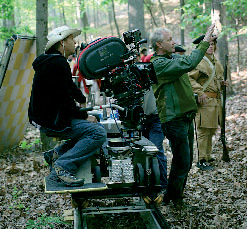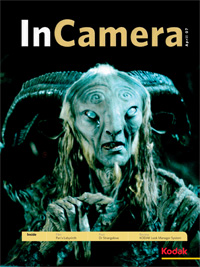A portrait of George Washington
|
Read more
at in70mm.com The 70mm Newsletter |
| Reprintet from Kodak's InCamera, April 2007 with permission | Date: 20.08.2008 |
 Director-cinematographer Kees Van Oostrum, ASC (right) discusses a
scene for with camera operator Chris Moseley (left). Photo by Kent Eanes Director-cinematographer Kees Van Oostrum, ASC (right) discusses a
scene for with camera operator Chris Moseley (left). Photo by Kent EanesWhen the Wall Street Journal surveyed historians and asked them to chose the best and most important American presidents, George Washington was number one on their list. When the newspaper asked ordinary people the same question, Washington was sixth. That was the essence of the challenge facing Kees Van Oostrum, ASC when he was asked to direct and shoot a docudrama about the life of George Washington. "We Fight To Be Free" was produced by Greystone Communications for display in two theaters in the new visitors center at the Mt. Vernon, Virginia, estate that was Washington’s home. The 22-minute film spans some 30 years of Washington’s life, concluding with his return to Mt. Vernon in 1797 after serving two terms as president. “All nonfiction filmmakers have a duty to inform and be truthful, but there is a huge difference between shooting a documentary for television and a re-enactment of history that will be presented in a cinema environment,” he says. “I saw this fi lm as an opportunity to paint a more complete picture of Washington as a human being. It demanded cinematic production values that transport audiences back in time.” The documentary was produced at practical locations in West Virginia, Maryland and Virginia, including the Mt. Vernon estate and on the banks of the James River. The cast was augmented by 100 re-enactors dressed in period costumes and uniforms. Van Oostrum filmed battles and scenic backgrounds in 65mm format in order to capture a naturalistic feeling of depth and dimension. Medium shots and intimate close-ups were filmed in Super 35 format. He says that use of the large format film provides a more immersive and compelling experience for less than a penny per spectator. “We were true to the period by lighting scenes primarily with candles and fires at night and daylight,” Van Oostrum says. “When necessary, we augmented that light with small Chimera soft boxes and sometimes HMIs angled to emulate sunlight.” His palette consisted of KODAK VISION2 50D 5201 fi lm and KODAK VISION2 200T 5217 film that was used for the few interior scenes and for exteriors shot at darker times of day. Van Oostrum covered big exterior scenes with as many as five or six cameras. One was usually operated at a high-speed frame rate for slow motion effects. Sometimes one or two cameras were placed on the ground and used to film re-enactors running towards or retreating from them. Those cameras were operated by remote control. |
More
in 70mm reading: "As Good as it Gets"- Demonstrates power of large format Internet link: Kodak screenarchives.com imdb.com mountvernon.org documentary.org jenreviews.com |
 InCamera
April 2007 edition. InCamera
April 2007 edition.“There are night and early daylight scenes at the camp in Trenton, where we want the audience to feel the cold and see real mountains and trees in the background,” he says. “We shot day for night, because it was impractical to light those big landscapes.” Van Oostrum used the RevolveR Motion Control System on the We fi ght to be free camera to multiply the 100 re-enactors into some 400 troops in various shots. The device enabled him to repeat zooming, focusing, panning and tilting moves in multiple takes. He framed the first take with re-enactors on the left side of the frame, and repeated it with them on the right side, top and bottom. The elements were composited during postproduction. Deluxe in Los Angeles processed some 16 hours of 35 and 65mm fi lm. After offline editing, EFILM in Los Angeles scanned the conformed 35mm negative at 4K resolution. DKP 70MM in Santa Monica scanned the 65mm film at 6K resolution. The master file was “rezzed” down to 2K to expedite interactive DI timing. "We Fight To Be Free" premiered last fall in two theaters that are part of the new Ford Orientation Center and Donald W. Reynolds Museum and Education Center at Mt. Vernon that Washington called home. The estate is operated by the Mt. Vernon Ladies’ Association, a non profit organization that is dedicated to keeping Washington’s memory and spirit alive. |
|
|
Go: back
- top - back issues
- news index Updated 21-01-24 |
|
